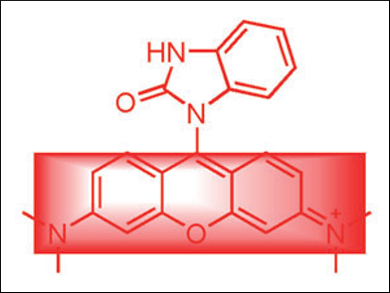The safe and accurate detection of chemical weapon agents, such as phosgene, is of high importance for public safety. Unlike nerve gas agents, e.g., sarin, the supply of which is strictly controlled, phosgene is more readily available.
Juyoung Yoon, Ewha Womans University, Seoul, Korea, Xue Wu, Yanbian University, Yanji, China, and colleagues have designed a molecule that can detect and discriminate between nerve-gas agents and phosgene. They functionalized the commercially available pyronin Y (PY) dye with an o-phenylenediamine (OPD) unit.
The resulting molecule (PY-OPD) is nonfluorescent, as photoinduced electron transfer occurs from the OPD to the PY units. This sensor reacts with phosgene to form a product that emits red fluorescence. In the presence of the nerve-agent mimic diethyl chlorophosphate (DCP), an adduct is formed that emits green fluorescence.
In order to produce a practical sensor, PY-OPD was immobilized on a polyethylene oxide membrane. The membrane is initially colorless and emits weak blue fluorescence, however after exposure to phosgene, its color changes to violet and its emission signal to pink-red. After exposure of the membrane to DCP, the color changes to yellow, and its fluorescence to pale white. This approach is a safe and simple method for discriminating and detecting chemical weapon agents.
- A Fluorescent Sensor for Dual-Channel Discrimination between Phosgene and a Nerve-Gas Mimic,
Xin Zhou, Yiying Zeng, Chen Liyan, Xue Wu, Juyoung Yoon,
Angew. Chem. Int. Ed. 2016.
DOI: 10.1002/anie.201601346


